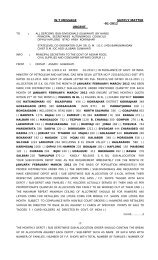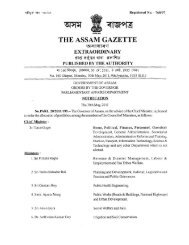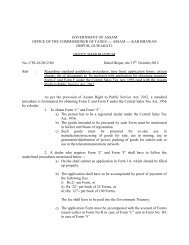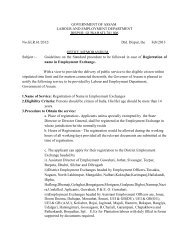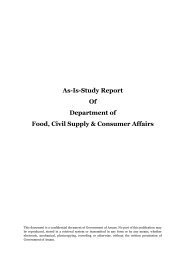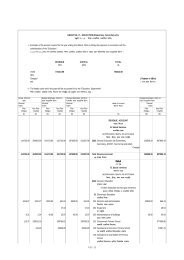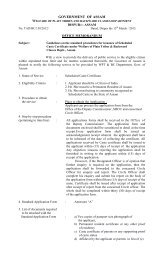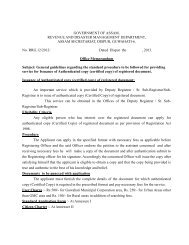public health engineering department - Assam Online Portal
public health engineering department - Assam Online Portal
public health engineering department - Assam Online Portal
You also want an ePaper? Increase the reach of your titles
YUMPU automatically turns print PDFs into web optimized ePapers that Google loves.
As-Is and e-Readiness Study report on Public Health EngineeringDepartment, Govt. of <strong>Assam</strong>Model 1:Upto Rs. 1500(including superstructure)BPL APL BPL APL BPLAPL60 Nil 20 Nil 20 100Model 2:Between Rs. 1500/- and Rs. 2000/- 30 Nil 30 Nil 40 100Above Rs. 2000/- Nil Nil Nil Nil 100 100The incentive given by the Central Government will continue to be admissible withreference to the cost of the basic low cost unit as given in the above Table and in nocase will the overall quantum of Central incentive exceed the admissible amount. As perthe above table the maximum incentive per toilet available to a BPL household will be Rs.1200.00 (Center + State), irrespective of the model chosen by it. State Government mayprovide for more incentive for household toilet than the amounts prescribed above fromits own funds. The BPL household may also contribute to value addition to the basic unitat its own expense. All houses constructed for BPL families under Indira Awas Yojanashall invariably be provided with a toilet under this programme.(f) Community Sanitary ComplexCommunity Sanitary Complex is an important component of the TSC. These Complexes,comprising an appropriate number of toilet seats, bathing cubicles, washing platforms,Wash basins etc, can be set up in a place in the village acceptable to women/men/landless families and accessible to them. The maintenance of such complexes is veryessential for which Gram Panchayat should own the ultimate responsibility or makealternative arrangements at the village level. User families may be asked to contribute areasonable monthly user charge for cleaning & maintenance. Maximum unit costprescribed for a community complex is upto Rs 2 lakhs. However, it will be approvedby the National Scheme Sanctioning Committee based on the detailed design andestimates. Sharing pattern amongst Central Government, State Government and thecommunity is in the ratio of 60:20:20. The community contribution, however, can be made bythe Panchayat out of its own resources, from grants of the Twelfth Finanace Commission orfrom any other fund of the State duly permitted by it. However, total expenditure proposed onCommunity Sanitary Complex and Individual Household Toilets should be within the ceilingof 60 percent of the total Project outlay. Ordinarily such complexes should be constructedonly when there is lack of space in the village for construction of household toilets and thecommunity owns up the responsibility of their operation and maintenance. The ultimateaim is to ensure construction of maximum IHHLs and construction of community complexeswill be restricted to only when IHHLs cannot be constructed, for whatever reason, and alsoteach the community of “Hygiene practices”. Such complexes can also be made at<strong>public</strong> places, markets, etc. where large scale congregation of people takes place.(g) Institutional ToiletsChildren are more receptive to new ideas and schools/Anganwadis are appropriateinstitutions for changing the behaviour, mindset and habits of children from open defecationto the use of lavatory through motivation and education. The experience gained by childrenthrough use of toilets in school and sanitation education imparted by teachers would reachhome and would also influence parents to adopt good sanitary habits. School Sanitation,therefore, forms an integral part of every TSC Project.Ref.: AEDC/AOP/EOI/2009/10 Copyright : AEDC Ltd. 57




